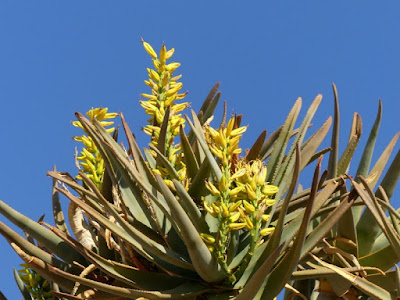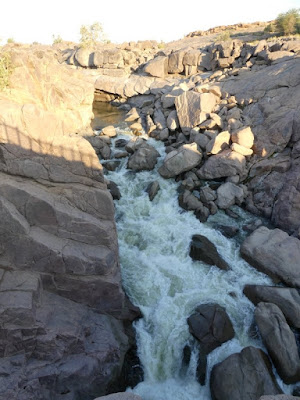I first visited Augrabies Falls, up near the Namibian border in north-western South Africa, back in 2005 and was smitten by it. To the north, in Botswana and Namibia, is the mighty Kalahari Desert. The northern part of South Africa along the Orange River where Augrabies Falls thunders is sometimes known (mostly for tourism purposes) as the 'Green Kalahari', to reflect the irrigation production along the river.
I was travelling alone then but was embarking on the relationship that has come to define the rest of my life, and was determined to share this wild arid land with Lou one day. One of its attractions for me was that it reminded me in many ways of outback Australia, and we both feel passionately about that. Finally, just before COVID changed the world forever and shut down international travel for who knows how long, we managed to get there (and back!). This post is a record of a brief but memorable time there.
 |
| The wild wide rocky landscape of Augrabies Falls National Park. |
 |
| The red arrow marks the approximate position of Augrabies Falls, on the Orange River some 120km west of the thriving (and not entirely lovable) frontier town of Upington. |
I would of course love to show you the full drama of the falls - they were pretty good when I was there in 2005 but that was pre-digital camera days for me - but the area was in severe drought at the time (as was most of Australia) so the falls were a relative trickle.
Compare this with the photos below, displayed on a board at the information centre, of the same falls during a wet year in 2010!
Downstream are access points to lookouts over the lower reaches of the gorge. Here the river has been temporarily reduced to near-stagnant pools; I don't know how much water is extracted upstream for irrigation.
 |
| Echo Corner. |
 |
| Oranjekom Lookout. |
 |
| A pool in the granite by the track, where birds came to drink. |
 |
| Slender Milk Bush Euphorbia dregeana; the 'milk' of the name refers to the caustic milky sap common to most euphorbs. |
Probably the most impressive plant of this part of the world however is the striking but endangered Quiver Tree, or Kokerboom, Aloidendron dichotomum in the family Asphodeleceae - a lily family which some of my Australian readers will know for the little Bulbine Lilies Bulbine spp. They are thus one of the few monocots (which are mostly herbs) to form a tree, along with palms.
 |
| They can seemingly grow in almost any substrate and are a substantial tree. |
 |
| Kokerboom flowers; it's not clear what prompts flowering, but it's obviously not rain. |
 |
| Cape Bunting Emberiza capensis, a dapper little dweller of dry rocky landscapes - just like Augrabies Falls in fact! |
 |
| Sickle-winged Chat Emarginata sinuata; all the comments about the previous bird apply to this one too, including its naming. It too is an Old World flycatcher. |
 |
| Pale-winged Starling Onychognathus nabouroup. This arid land starling has learnt at Augrabies to hang around the restaurant in hope of handouts or leftovers. |
 |
| Red-eyed Bulbuls Pycnonotus nigricans are also dryland birds (as you must be to live here) which readily adapt to human habitations. |
 |
| These two were coming for a slightly risky drink at the falls. |
 |
| Spike-heeled Lark Chersomanes albofasciata, displaying its distinctive 'heels'. |
 |
| Sabota Lark Calendulauda sabota; sabota is the general word in Tswana (or Setswana), widely spoken in north-western South Africa, for a lark. |
 |
| White-throated Canary Crithagra albogularis. Yes, there are plenty of 'real' wild canaries out there, including this one from the dry south-west of the continent. |
 |
| Pale Chanting Goshawks Melierax canorus feed on smaller prey including mammals, birds, reptiles, insects and even carrion across dry southern Africa. |
 |
| Angulate Tortoise Chersina angulata by the road; this hardy small tortoise is sadly threatened by the illegal pet trade, apparently. Fortunately not this one, I imagine. |
 |
| Rock Hyrax dozing on some comfortable granite in the late sun. |
 |
| Small Grey Mongoose Galerella pulverulenta which was cautiously investigating the situation in bushland alongside the restaurant, after most people had left. |
 |
| Yellow Mongoose Cynictis penicillata in a now quiet late afternoon picnic ground. Like the previous species, the Yellow Mongoose is comfortable around humans. |
 |
| Gemsbok Oryx gazella, at home in the wild rocky landscape of Augrabies Falls. |
 |
| Red Hartebeest Alcelaphus caama - another big, and generally solitary antelope. |
 |
| Southern, or Cape Giraffe Giraffa giraffa. Not just springboks can defeat the thorny plant protectors; these huge browsers seemed quite immune to them. |
 |
| I hadn't really thought of giraffes in a desert, but these certainly seemed at home. |
And remember that you can get a reminder when the next post appears by putting your email address in the Follow by Email box in the top right of this screen.
I'd love to receive your comments - it's easy and you don't need to sign in!
no control over it. I keep hearing of people who are no longer getting
notifications of new postings and I'm losing readership presumably as a result.
You might like to set a calendar alert as a back-up to avoid missing out.
Alternatively, if you'd like to send me an email (to calochilus51@internode.on.net)
I can put together a mailing list to send out whenever a post goes up;
I guarantee never to use your address for any other purpose.
Thank you!















3 comments:
You said "Pale-winged Starling Onychognathus nabouroup. This arid land starling has learnt
at Augrabies to hang around the restaurant in hope of handouts or leftovers."
At Tarangire National Park in Tanzania a species of Starling (I think Red-winged, but it is 20 years ago) came into the restaurant, in quite large numbers to get food at the source. That was the same Park where wild elephants grazed about 3 metres away from the wazungu having a cleansing ale before entering said restaurant!
Thank you Ian for a wonderful post. I too fondly remember this park. And for us it was our first ever trip to Africa, back in 2001 - so a 20-year nostalgia trip for me. (And as Kathy has already said on your Facebook post, we were camped here on 11 Sept, when patchy news broke of the terrorist attacks in USA. As we were heading into the Kalahari, there was no TV so we weren't aware of most of the horror until a week or two afterwards. Another even that changed travel significantly. John Goldie 14-4-21.
Thank you both for this - just back from the Blue Mountains and catching up.
Martin, I think the Tarangire NP restaurant starlings were probably Superb. Another truly wonderful park. I suspect that the wazungu are kept a little further from the elephants these days - not that I'd need encouragement to keep my distance!!
Hi John. What an excellent intro to Africa; mine was two years later, but also involved the Kalahari. On that 11 Sept I was running a tour in SWWA and recall people running across the cabin park in the Stirling Ranges to bombard me with horror details the moment I stepped outside the cabin early in the morning. Fortunately all my associations with Augrabies are positive!
Post a Comment